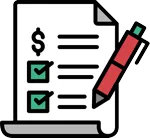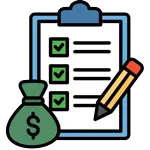Planning for retirement is inherently difficult. We don’t know how long we will work. We don’t know exactly how much our pension and/or Social Security will be. We don’t know how much we will spend in retirement. And we don’t know how long we will live.
So we face the difficult dilemma of balancing how much we take care of “present me” with how much to sacrifice today to take care of “future me.” While behavioral economists suggest that human beings tend to put too much emphasis on present me, each of us has our own time bias that we need to be aware of.
The principles below can help you make a more informed decision when it comes to striking this balance.
General principles:

1. Save something.
Before you start socking money away for retirement, be sure you have an appropriate emergency fund. Many experts recommend three to six months of expenses. Keep these funds in a high-yield savings account—which earns an above-average interest rate—to protect against inflation. Also, prioritize paying off high-interest debts. If you have a credit card balance with a 30 percent interest rate, it probably doesn’t make sense to prioritize money for retirement that may, at best, earn 10 percent per year on average.
2. Save in a cost-effective way.
In my experience, many school employees don’t realize how terrible their schools’ 403(b) plans are, which are rife with low-performing, high-cost investments.
For example, I showed an elementary school teacher that even though she had chosen a good mutual fund from her 403(b) provider, the provider charged an outrageous fee of 1.25 percent every single year. This may not sound like a lot, but over 30 years of putting away $200 biweekly at a 7 percent annual rate of return, this fee would mean a loss of well over $100,000!
If your school district doesn’t offer a high-quality 403(b) plan, consider putting in just enough to get your employer’s match (if they offer one) and consider putting the rest of your retirement investments in a Roth IRA (check IRS contribution and income limits) and/or in a regular (i.e. taxable) investment account. Either way, consider sticking with low-cost index funds for your investments.
3. See a fiduciary.
Whether you’re just getting started or think you are ready for retirement, consider seeing a fiduciary for a financial checkup. A fiduciary can help evaluate your specific situation and what you can do to achieve your goals.
4. Automate.
We all struggle to keep up routines. Make life easier and have your investments automatically deducted from your paycheck or bank account each month.
20–30 years old

1. Consider investing in stocks.
While stocks aren’t for everyone, younger people should know that the worst 30-year return in the U.S. stock market since 1926 was an average annual rate of 7.8 percent—and that time span included the Great Depression, when the stock market fell more than 50 percent.
We don’t know the future, but investing $200 biweekly at 7.8 percent for 30 years would yield a portfolio of more than $600K.
2. Keep it simple.
Depending on your risk tolerance, consider investing in a total stock market index fund that includes international stocks, or a target-date fund that automatically gets more conservative as you get closer to retirement.
3. Embrace market downturns.
Historically, the market has always recovered from a crash, and many of us have made the mistake of stopping our contributions or selling investments during a market crash. However, these have been incredible opportunities for investors.
4. Consider appropriate life insurance.
How much you need depends on your goals and circumstances (i.e. paying off the mortgage or sending kids to college), but choosing low-cost term life insurance instead of an expensive whole life policy can help you save more for retirement.
Quote byMark Ashe

40 year olds

1. Assess how much you have saved.
Look at how much you have now and how much you may need to save by the time you retire. The average retiree spends 75 percent of the annual income they had while working.
2. Plan for the spending gap.
You will need enough retirement savings to make up any gap between your expenses and anticipated pension and/or Social Security. A simple rule of thumb is to divide your annual spending gap by 4 percent. This can provide a rough estimate of how much savings you may need for a 30-year retirement. So, if you anticipate a $30,000 annual gap between your retirement income and retirement spending, dividing this number by 4 percent would mean that $750K in retirement savings may be necessary. Then use this rough estimate to see if you are on track to reach this goal by retirement.
50–60 years old

1. Determine whether you still need life insurance.
By now, your retirement nest egg may be big enough to protect your family should you pass away unexpectedly. If you no longer need the insurance, put any unneeded insurance premiums toward your retirement savings.
2. Reevaluate when you are five to seven years out from retirement.
Ensure that your portfolio is well diversified with a few different stock and bond funds. This makes managing your portfolio more complicated, but it gives you more options when drawing income from your portfolio in retirement because sometimes international stocks go up when U.S. stocks go down, and sometimes bond funds go up when stock funds go down. This may help protect your retirement plan from being sidetracked by a declining market.
3. Pay off high-interest debt.
It’s best to pay off credit cards and other high-interest debt. But carefully assess whether or not you should pay off a mortgage with a low interest rate (below 5 percent), as keeping your mortgage can help avoid cash-flow problems in retirement (especially if your investments can earn at least 5 percent). It is hard to pull money out of a home to buy groceries compared with selling a stock or bond fund.
Planning for retirement can feel like trying to hit a moving target. But regardless of what career stage you are in, taking just one meaningful step can help you feel more confident about taking care of “future you.”
Mark Ashe has taught economics and personal finance in public schools for more than 25 years. He is a licensed investment advisor and fiduciary. The commentary in this article is not professional investment advice or an endorsement of any kind. This article is for informational purposes only and should not be relied on to make any investment decisions.


